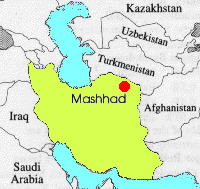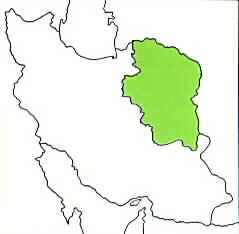 |
|
|---|

| |
|---|---|
City Significance and History
... Map of Mashhad - Zoom up to street level 
History of Imam Reza's Shrine Nader Shah Mausoleum and Museum Khaje Rabi Mausoleum Who is a Mashtee?? Mashhad Image Gallery Mashhad Rugs Travel Information, Travel Agencies Mashhad Weather - Current conditions and 5 day forecast Province of Khorasan ... Khorasan News Paper Neyshabur - Hakim Omar-e-Khoyyam & Attar Ferdowsi - Hakim Abol-Ghasem Ferdowsi Toosi (940-1020 AD) Saffron - ZahFaron, The most expensive spice in the world Area Code of Cities in Iran Visitors' Opinion, Comments and FAQ | 
|
|
Khorasan | |||||||||||||||||||||||||||||||||||||||||||||||||||||||||||||||||||||||||||||||||||||||||||||||||||||||||||||||||||||||||||||||||||||
|---|---|---|---|---|---|---|---|---|---|---|---|---|---|---|---|---|---|---|---|---|---|---|---|---|---|---|---|---|---|---|---|---|---|---|---|---|---|---|---|---|---|---|---|---|---|---|---|---|---|---|---|---|---|---|---|---|---|---|---|---|---|---|---|---|---|---|---|---|---|---|---|---|---|---|---|---|---|---|---|---|---|---|---|---|---|---|---|---|---|---|---|---|---|---|---|---|---|---|---|---|---|---|---|---|---|---|---|---|---|---|---|---|---|---|---|---|---|---|---|---|---|---|---|---|---|---|---|---|---|---|---|---|---|
|
Major Cities: Mashhad, Neyshabur (Nishapur) In Persian (Farsi), "khor" means "sun" and "san" means "the place", "the dwelling". Khorasan being situated in the East of Iran, is the "place where the sun rises". Historical Khorasan, also known as "Great Khorasan" included present day Khorasan as well as Transoxiana and Afghanistan. It was in the 19th century, during the reign of the Qajars, that the frontiers as we know them today, were established. The vast territory of Khorassan once covered parts of today's Afghnistan, Tadzhikistan, Turkmenistan and
The historical and famous province of Khorassan is the country's largest province with an area of 314,000 square kilometers. It is bounded on the north by the Republic of Turkmenistan, on the east by Afghanistan, on the South by the provinces of Kerman and Sistan & Baluchestan. and on the west by the provinces of Yazd, Semnan and Mazandaran. The word Khorassan means "where the sun rises", i.e., the East. It is a land of mountains and deserts with endless horizons and a unique enchanting tranquillity and splendor. There are various types of hunting animals, protected environments, a national park, and on the whole an intact natural setting in this province. This region has always occupied a strategic position in this part of the world. It forms a natural fortress in the heart of Central Asia while forming a corridor of communication between the steppes and the civilized populated regions of the Near East. Nomads have been attracted to this place, since time immemorial until the end of 19th century when the more or less impenetrable frontiers put an end to this migratory flux. Until the advent of Islam, Khorasan was one of the four largest satrapies of the Sassanid empire. It then became the doorway through which Turkic people - the Ghaznavids (end of 10th century), the Seljuqs (11th century) and then the Mongols (13th century), and the Timurids (14th-15th centuries) penetrated Iran. At the beginning of the 16th century, Khorasan was invaded by the Uzbeks, who in turn got chased out by the Safavids, a dynasty of Turkish origin. After the fall of the Safavids, Khorasan went through a period of total anarchy and order was only reestablished in the 18th century under Nader Shah Afshar who turned Mashhad into his capital. Under the Qajars, Northern Khorasan was constantly raided by neighboring Turkmen tribes. When part of Turkmenistan was turned over to Russia, the imperial armies put an end to these raids.
Present day Khorasan is the largest province (313,000 km2, some
115,830 square miles) and one of the most populated regions of
Iran. Its capital, Mashhad is also a holy city of Shi'ite Islam
(it houses the shrine of the 8th Imam, Reza). Its northern
mountainous region lives off a relatively flourishing agricultural
and pastoral economy. The South is mostly enclosed deserts and
salt plains; however, there is an enclave of highlands around
Birjand and Qa'in where life is centered around oases.
Khorason EconomyThe province's economy is based on agriculture (grains, beet, saffron, cotton and fruits), animal husbandry, light and heavy industry and rich mineral resources including natural gas (in Sarakhs).Khorason ClimateThe climate in different areas varies from hot and dry to cold highland weather; or to mild and temperate, but generally with little rain and humidity. The most well known rivers of Khorassan are Atrak, Kashaf Roud and Ghara Sou.Khorason Demographics
The People of KhorasonAccording to the latest population census, Khorassan has a population of over five million people who are generally Muslims and Persian speaking. Local dialects are also spoken in parts of the province. Other languages spoken sporadically in the area are Turkish, Kurdish and some Arabic. There are really few religious minorities in this province and they speak their own languages.Khorason, especially in the north, is characterized by a large ethnic diversity. Over a surface of 15,444 square miles, all the ethnic groups that compose the population of contemporary Iran can be found: Kurds, Balouchis, Lors, Turks, Turkmens, Sistanis, Afghanis, Arabs, etc... The existence of this mosaic of people is due to historical reasons. The presence of several of these ethnic groups such as the Turks goes far back in time. On the other hand, others, like the Kurds, have been forcefully settled. The Kurds were deported from their homeland during the reign of the Safavids in order to reinforce the defense line of the north eastern border. The other ethnic groups are the Lors, Arabs, Balouchis and certain groups of Turkmen. Because of its climate and the superior quality of its pastures, Northern Khorason has attracted many nomads and semi-nomads of neighboring Balouchistan and Sistan. Music in the culture of KhorasonDue to its ethnic diversity and the existence of different languages and religious observations (Sunni and Shi'a), the musical tradition of Khorason is very rich. From the north to the south, the music scene varies greatly. In the north of Khorason, one can find the bakhshi narrating and singing, among other things, "dastans" (stories in Turkish), although they can also sing in Kurdish about the historical deeds of local figures. They accompany themselves on the dotar. One can also find in the north, the Asheq who play "dohol" (double-faced drum), the "sorna" (a kind of oboe-like reed instrument) and the "qoshme" (double clarinet made of the central nervure of the plumage of birds tied together). The Asheq are specifically associated with the Kurds and play at wedding dances and village feasts. In the East of Khorason, near Torbat and Jam, the main instrument is the dotar (with some modifications), but there are no Bakhshi and the music is different. Here, the music takes the form of "ghazal khani'" and is performed by singers of quatrains and "ghazals" - lyric poems based on the invocations of mystic poets like Rumi, Attar and Sheikh Ahmad Jami. Purely instrumental pieces also figure in the repertoire. More towards the south, in the regions of Birjand and Qa'in, the musical culture changes again: the dotar is no longer present (although it seems that in the past, it was played). The songs are called "sotak" and are accompanied on the "dayereh" (tambourine). | |||||||||||||||||||||||||||||||||||||||||||||||||||||||||||||||||||||||||||||||||||||||||||||||||||||||||||||||||||||||||||||||||||||
|
|
|---|
Your Opinion Counts. Check Mashhad Webpage surfers' Opinion and Comments.
Copyright © 1996-2025 FarsiNet Inc. All Rights Reserved. (032196)
 Uzbekistan when it was called the greater Khorassan. Khorassan has been the cradle of the Persian language
and the civilization of eastern Iran. Socially and politically it has always had an extraordinary importance in the
organization of the Iranian state. In the post-Islamic period, Khorassan was the first place where men like
Abu Muslim and Taher Zulyaminayn began their struggle for independence against the influence of the Umavid
and Abbassid khalifs. Cities like Marv, Bukhara, Samarkand and Balkh were the capitals of Taherian, Samanid,
Ghaznavid, Seljuk and Kharazmshahian states and the centers for the expansion of the Persian language and culture.
Khorassan was destroyed by the invasion of Mongols, but stood against the invaders with uprisings and
movements like Sarbedaran. Enemy troops again invaded Khorassan during the reign of Afshars and, Qajars; and
finally some major parts and cities of it were separated from Iran and annexed to Turkmenistan and Afghanistan,
during the expansion of the British and Russian colonial influence in Iran.
Uzbekistan when it was called the greater Khorassan. Khorassan has been the cradle of the Persian language
and the civilization of eastern Iran. Socially and politically it has always had an extraordinary importance in the
organization of the Iranian state. In the post-Islamic period, Khorassan was the first place where men like
Abu Muslim and Taher Zulyaminayn began their struggle for independence against the influence of the Umavid
and Abbassid khalifs. Cities like Marv, Bukhara, Samarkand and Balkh were the capitals of Taherian, Samanid,
Ghaznavid, Seljuk and Kharazmshahian states and the centers for the expansion of the Persian language and culture.
Khorassan was destroyed by the invasion of Mongols, but stood against the invaders with uprisings and
movements like Sarbedaran. Enemy troops again invaded Khorassan during the reign of Afshars and, Qajars; and
finally some major parts and cities of it were separated from Iran and annexed to Turkmenistan and Afghanistan,
during the expansion of the British and Russian colonial influence in Iran.